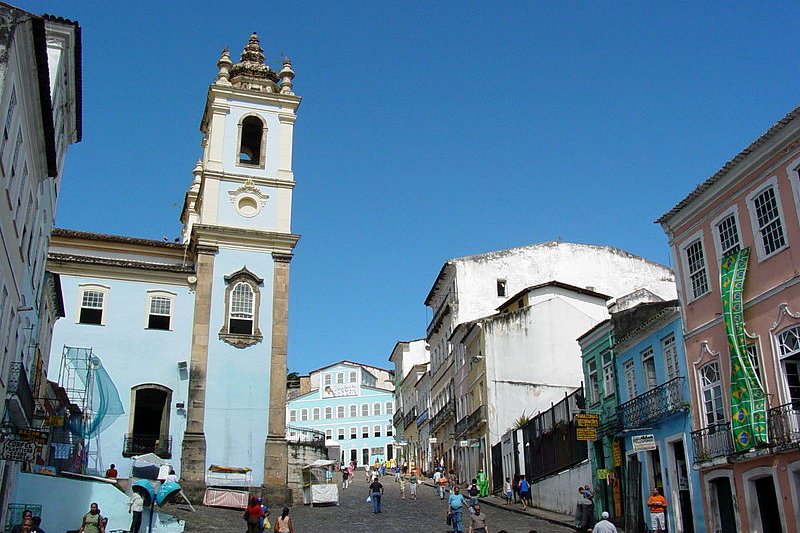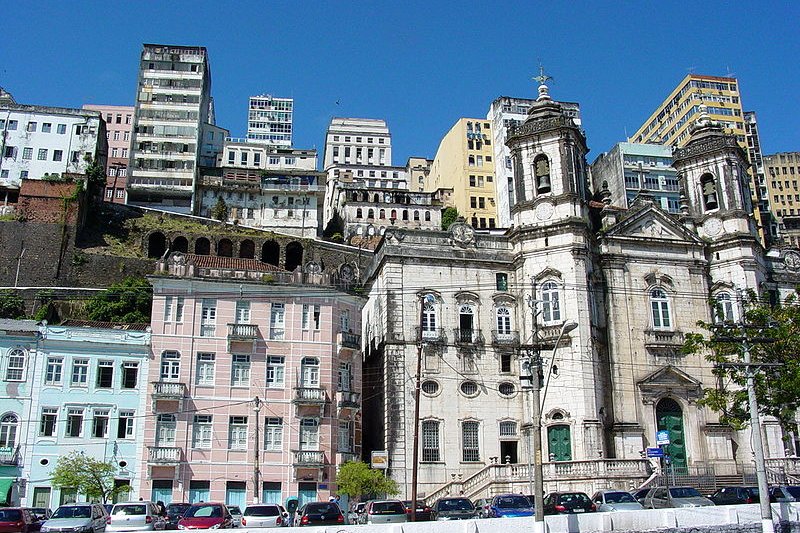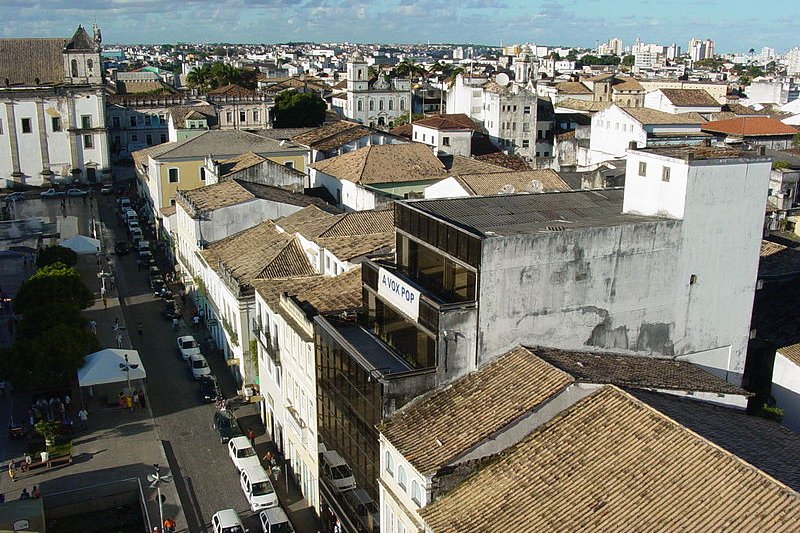 Salvador, Brazil
Salvador, BrazilSource: https://commons.wikimedia.org/wiki/File:Street_Scene_-_Salvador_-_Brazil_02.jpg
Author: Adam Jones

Salvador is the state capital of Bahia, in northeastern Brazil. Covering 706 sq km (272 sq mi), it has a population of 2.7 million people (2011 estimate) within a metropolitan area of 3.9 million.
Salvador is the oldest city in Brazil as well as in the New World. It was the first capital of Brazil, between 1549 and 1763. The Portugese arrived at Baía de Todos os Santos (All Saints Bay), in the Bahia coast, in 1500. This led to the founding of the settlement on 29 March, 1549. The city was originally called Salvador de Bahia, and for a while known simply as Bahia. It comprises the upper city, where the civic buildings and residential neighborhoods are located, and the lower city, which is the financial center.
Salvador is a place where the cultures of Europe, Africa and Native America come together. Salvador de Bahia holds the dubious honor of being the site when the first slave market in the New World was established in 1558, when African slaves were imported to work in the sugar plantations. Its old town, called the Historic Center of Salvador de Bahia, was inscribed as a World Heritage Site during the 9th session of the World Heritage Committee meeting at Headquarters in Paris, France, on 2-6 December, 1985.
Salvador
 The buildings of Salvador, as seen from the harbor
The buildings of Salvador, as seen from the harborSource: https://commons.wikimedia.org/wiki/File:Building_Facades_-_Harbor_at_Salvador_-_Brazil.jpg
Author: Adam Jones

Salvador served as the first capital of Brazil until 1763, when the capital was moved to Rio de Janeiro. It was the base of the Brazilian independence movement. Somehow bypassed by industrialization, the city went into gradual decline from the 19th century. By the mid 20th century, its fortune reversed, and it grew from being the fourth largest city in Brazil in 1948 to the third largest in 2008.
Salvador de Bahia World Heritage Site Inscription Details
Location: S 12 58 W 38 30Inscription Year: 1985
Type of Site: Cultural
Inscription Criteria: IV, VI
Visiting Salvador
You can fly to Salvador, arriving at the Deputado Luis Eduardo Magalhães International Airport (SSA), which receives flights from all over Brazil, as well as from Buenos Aires, Frankfurt, Lisbon, Madrid, Miami, Milan, Natal, and Paris, among others. The airport is 28 km from downtown and 32 km from the beaches. Pelourinho district, Salvador
Pelourinho district, SalvadorSource: https://commons.wikimedia.org/wiki/File:View_over_the_Pelourinho_District_-_Salvador_-_Brazil_02.jpg
Author: Adam Jones

The most practical way to leave the airport is to take the prepaid executive taxi or the metered normal taxis. There are also minibuses to Praça da Sé, in downtown Salvador, and regular buses to different parts of the city.
Sights & Attractions in Salvador
- Pelourinho
This is the restored historic center of Salvador, today a World Heritage Site. - Catedral Basílica
The main cathedral of Salvador, built in 1672, and regarded as one of the most outstanding examples of Portuguese Baroque architecture. - Elevador Lacerda
This is an outdoor elevator connecting the Lower City with the Upper City. Originally a manual pulley dating to 1873, it was replaced with the present Art Deco piece in the 1930s. - Forte de Santo Antônio
Fort built in 1535, around which Salvador was established. It remains one of the major landmarks of the city today. - Fundação Casa de Jorge Amado
A small museum celebrating the works of Brazilian author Jorge Amado (1912-2001). Although he never lived in the city, many of his novels are set there. - Igreja e Convento de São Francisco
This religious complex is one of the most impressive collection of Baroque buildigns in Brazil. It was built between 1708 and 1750. Its church is renowned for its magnificent interior. - Memorial das Baianas
Historic building celebrating the women of Bahia. It showcases the ceremonial clothings and adornments of Baianas. - Mercado Modelo
Once the Customs House built in 1861, it was readapted in 1984 into an indoor craft market. - Museu Afro-Brasileiro
Museum celebrating the culture of the African diaspora in Brazil, with objects related to African culture and religious beliefs. - Museu de Arte da BahiaAlso known as Palacete de Vitória, this museum offers a glimpse into the lifestyle of the rich colonial elites of Salvador, with its collection of paintings, furniture, silverware, china, and other items from the 18th to the early 20th centuries.
- Museu de Arte Sacra
Museum with one of the biggest collection of religious art in Brazil. It occupies a former Carmelite convent built between 1667 and 1697. - Museu Tempostal
Museum occupying a beautiful colonial house in Pelourinho. It offers a glimpse at the vast collection of postcards and photographs belonging to its founder, Antônio Marcelino. - Nosso Senhor do Bonfim (Our Lord of Good Success)
Church built in 1746 by Captain Rodrigues de Faria to fulfil a pledge he made while traversing an Atlantic stormy. The church is dedicated to God the Father, but also honors the African deity Oxala of the Candomblé religion. - Palácio Rio Branco
The original building, erected in 1549 was the first governor's house. It survived until 1900, when it was demolished and rebuilt in the Renaissance style. Then a fire broke out in 1912, and it was renovated again. It was used as a government building until 1979, when it was turned into a cultural center. - Praça da Sé
Public square in Salvador. - Solar do Unhão
This is a former sugar mill dating to the 17th century that was designated a historic monument in the 1940s and today used as the museum of modern art.
 Latest updates on Penang Travel Tips
Latest updates on Penang Travel Tips
Songs about Penang
About this website

Hello and thanks for reading this page. My name is Timothy and my hobby is in describing places so that I can share the information with the general public. My website has become the go to site for a lot of people including students, teachers, journalists, etc. whenever they seek information on places, particularly those in Malaysia and Singapore. I have been doing this since 5 January 2003, for over twenty years already. You can read about me at Discover Timothy. By now I have compiled information on thousands of places, mostly in Peninsular Malaysia and Singapore, and I continue to add more almost every day. My goal is to describe every street in every town in Malaysia and Singapore.
Copyright © 2003-2024 Timothy Tye. All Rights Reserved.


 Go Back
Go Back